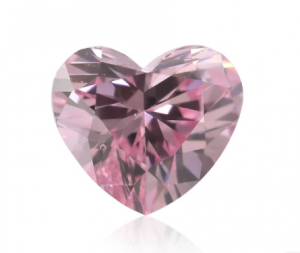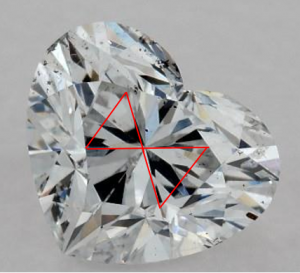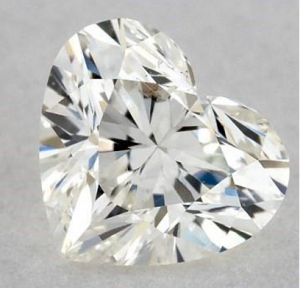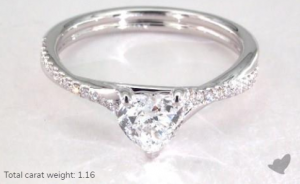This page contains references to diamonds or engagement rings from different companies. Sometimes I do receive a commission when you click on links and buy the products.
Intrinsically linked to love and romance, the heart shaped diamond naturally lends itself to sentimental pieces of jewelry, the most popular of these, of course, being an engagement ring.
This rare and complex cut is all about balance; while it remains an unusual choice for jewelry it is that very fact that sees buyers searching for the best heart cut diamond.
When it is done well, a heart shaped diamond stands out from the crowd with a symbolic beauty and soft symmetry. Like any other cut of diamond, the performance of a heart shape is dependent upon the cut, color and clarity of the stone, and an understanding of these will ensure you get the best possible diamond for the best possible price.
The Cut
A heart shaped diamond is a form of modified brilliant cut. As the name suggests, modified brilliant cuts are brilliant cut diamonds that differ from a round shape.
Modified brilliants are popular choices for jewelry as their faceting pattern offers the same dazzling sparkle of a traditional round brilliant cut.
The most well-known, hand-cut modified brilliants are pear cut and oval cut, however with modern laser cutting technology the term now refers to a whole host of shapes, including butterflies and stars.
2.72 ct F VVS2 Heart Cut Lab Grown Diamond from Whiteflash
Any diamond cut that has been adapted from the round brilliant cut would be referred to as a modified round brilliant.
Unlike the round brilliant, there are no set cut parameters for a heart shaped diamond. This is due to the fact that there is an element of personal taste when it comes to the ratio of the stone; some people prefer a longer heart (particularly popular in pendants) which others prefer the wider, rounder shaped heart.
There are, however, some widely accepted guidelines for assessing the cut of a heart shaped diamond which are as follows:
| Excellent | Very Good | Good | Fair | Poor | |
|---|---|---|---|---|---|
| Table % | 53-63 | 52 or 64-65 | 51 or 66-68 | 50 or 69-70 | <50 or >70 |
| Depth % | 58-62 | 56-57.9 or 62.1-66 | 53-55.9 or 66.1-71 | 50-52.9 or 71.1-74 | <50 or >74 |
| Girdle | Very Thin – Slightly Thick | Very Thin – Slightly Thick | Very Thin to Thick | Very Thin to Very Thick | Ex. Thin to Ex. Thick |
| Culet | None | Very Small | Small | Medium | >Medium |
| L/W Ratio | 0.95-1.02 | 0.89-0.94 or 1.03-1.05 | 0.83-0.87 or 1.06-1.10 | 0.80-0.83 or 1.11-1.15 | >0.80 or <1.15 |
The heart shaped diamond is made up of five areas; these areas determine the appearance of the stone, and also enable the buyer to differentiate between the variations in shape.

Some people may ask for a stone with elongated lobes and a narrower belly, while others may insist on a flatter wing and narrow point.

James Allen 0.50 Carat J-VS2 Heart Shape Diamond James Allen 0.50 Carat D-I1 Hear Shape Diamond
On the left, a 0.50ct heart with wide lobes and a rounded belly and wings. On the right, a 0.50ct heart with narrower wings and pointier lobes.
Taste is certainly a factor, however there are certain ‘must-haves’ when evaluating heart shaped diamonds:
- The overall shape must resemble that of a traditional heart. Overly pointed lobes and flat wings create a shape that is more like an arrow, and therefore less desired when looking at a heart shaped cut.
- Symmetry is everything. You should consider the length to width ratios a guideline but it is also important that you assess the stone by eye. Imagine a line down the center of the diamond and evaluate the balance and symmetry of the lobes and wings.
- The cleft should be even and defined. A soft or subtle cleft is a sign of a badly cut heart diamond and doesn’t give the pronounced heart shape that is desirable.
A true heart requires an expertly skilled cutter so be sure to know what to look out for to avoid any dud cuts.
The Bow-Tie Effect
The bow tie effect is a tell-tale sign of a badly cut diamond. This phenomena effects oval, marquis, pear, and heart shaped diamonds. It is a black shadow pattern across the diamond that resembles the shape of a bow tie.
It is the result of light obstruction and facets that are unable to ‘bounce’ light back towards the eye, causing the dark, black shadows to appear.
Avoiding the bow tie effect requires a skilled cutter who has carefully considered the angles and proportions involved in all of the diamond, not simply those which may display the bow tie effect. Being able to identify this flaw in a diamond will allow you to easily rule out a large amount poorly cut diamonds, before looking further into the exact cutting proportions.
Carat Weight
Choosing a carat weight is largely dependent on budget and personal taste; for other diamond cuts, I simply suggest finding the carat weight that works best for you. Heart shaped diamonds are a little different.
The reason that this cut hasn’t hit the peak popularity of modified cuts is largely down to carat weight, specifically how much carat weight is needed! It is usually advised to look for heart shaped diamonds at a minimum weight of 1.00ct.
Heart shaped diamonds are fairly ‘deep’ meaning they look smaller than other modified brilliants of the same carat weight. Perhaps more significantly though, their distinct shape is not visible in smaller carat weights. A small heart shaped diamond (particularly in a poorly chosen setting) can simply look like a warped round brilliant.
It is possible to find a smaller, heart shaped diamond which can look delicate and dazzling in the right setting, but on the whole, it is a shape that is better suited to those who can consider diamonds of 1.00ct and above.
Color
Heart shaped diamonds hold their color a little more than a round brilliant, but color is where you can make a saving on your stone. An I-G in color would be recommended, although J in a warm setting (such as yellow or rose gold) can still appear colorless. Some people are naturally more sensitive to color in a diamond, so it is imperative that you see the stone through high-res photography or 360 imaging before you buy. Online jewelers like James Allen and Whiteflash have such capabilities for you to view the diamonds online before committing with HD Videos and Diamond Imaging.
Heart shaped diamonds also look stunning in other colors like this delicate purple/pink heart from Leibish.
Leibish 0.15 Carat Heart Shape Fancy Intense Purplish Pink Diamond VS1
Choosing a colored diamond can also help emphasize the shape of a stone, distinguishing it from the setting and allowing it to show off its unique silhouette.
Clarity
As a brilliant cut, the facets of a heart shaped diamond are adept at hiding inclusions. This means you can look for an eye-clean SI1 stone, allowing more of our budget to be spent on cut and bumping up the carat weight.
Choosing a clarity is all about finding an eye-clean stone. Even diamonds of a VS2 grading can have unfortunately positioned inclusions which will detract from the overall beauty of the diamond. It is also important that there are no inclusions in the point of the diamond, as this can compromise the durability of the stone making it more prone to chipping.
James Allen 0.52 Carat I-SI1 Heart Shape Diamond
This SI1 from James Allen has no dark inclusions in the table, in the wings or point of the diamond. The smaller inclusions towards the cleft and left-hand lobe would go unnoticed by eye, particularly once the diamond is in a setting.
Heart Shaped Diamonds Rings & Settings
Choosing a setting for a heart diamond is all about emphasizing the shape. One option is a claw setting; positioning is everything, so look for settings where the claws are enhancing the shape of the diamond as opposed to distorting it.
James Allen 1.01 Carat Heart Shaped Pave Engagement Ring in 14K White Gold
This ring from James Allen is a good example of claws being used to protect and enhance a heart shaped stone. The top claws emphasize the lobes while the rest of the claws are concentrated towards the bottom half. The point of the heart is also protected which is essential when looking at settings for any diamond with pointed extremities.
Another popular option is a halo setting. A diamond shaped halo will further enhance the unique and symbolic shape of the diamond, while also making the ring appear bigger on the hand. A halo setting adds impact, sparkle and a defined silhouette to a heart shaped stone.
This ring from James Allen shows the beautiful combination of a warm rose gold setting with the soft curves of a heart shaped diamond, perfectly held in a halo setting.
James Allen 0.80 Carat Heart Shaped Halo Engagement Ring in 14K Rose Gold
If you are looking to set a smaller diamond (which in this case is anything below 1.00ct) but do not wish to use a halo, I would recommend looking for a 3 claw setting like the one used in this ring.
James Allen 1.01 Carat Heart Shaped Pave Engagement Ring in 14K White Gold
The 3 claws hold the diamond while still allowing much of the circumference of the diamond to show. This helps to keep the shape of the heart clear.
Heart Shaped Lab Diamonds: A Modern Choice with Timeless Appeal
Lab-grown diamonds have been making waves in the jewelry industry, offering a more sustainable and ethical alternative to mined diamonds. Heart shaped lab diamonds, in particular, combine the modernity of lab-grown technology with the timeless symbol of love and romance.
Considerations When Purchasing a Heart Shaped Lab Diamond:
- Cut and Symmetry: The heart shape is intricate and requires precision. Ensure that the lobes, wings, and cleft of the diamond are symmetrical. The overall shape should resemble a traditional heart, avoiding overly pointed lobes or flat wings.
- Certification: Always opt for diamonds certified by recognized institutions like the International Gemological Institute (IGI) or the Gemological Institute of America (GIA). These certifications ensure the diamond’s quality and authenticity.
- Avoid the Bow-Tie Effect: This is a shadow pattern that can appear across the diamond, resembling a bow tie. It’s a sign of a poorly cut diamond. Ensure your heart shaped diamond doesn’t exhibit this effect.
- Size Matters: Heart shaped diamonds, especially those below 1.00ct, can sometimes appear like a distorted round brilliant. It’s often recommended to go for diamonds at a minimum weight of 1.00ct to truly appreciate the heart shape.
Where to Purchase:
- Whiteflash: Known for their exceptional quality and high quality images, Whiteflash is a great place to start your search for the perfect heart shaped lab diamond.
- James Allen: With high-resolution photography and 360 imaging, James Allen allows you to view diamonds in great detail before making a purchase. Their collection of heart shaped diamonds is impressive.
- Brilliant Earth: Committed to ethical sourcing, Brilliant Earth offers a wide range of heart shaped lab diamonds. Their commitment to sustainability makes them a top choice for the eco-conscious buyer.
The Final Word
When choosing a heart cut, expect to be looking at bigger carat weights to get the most from this enchanting diamond. While other diamond shapes may be a little more flexible, paying equal focus and attention to the four C’s and the setting will result in a ring like no other.
Pay particular attention to the curves and symmetry of the diamond, as these are big indicators of cut quality. Avoid the bow tie effect and be sure to view your diamond under the most authentic conditions possible (high-res photography, 10x magnification, and 360 imaging).
A stone with such sentiment deserves a setting that will stand the test of time; choose platinum or 14k – 18k gold for the best results and be sure the tip of the diamond is protected.
Beyond this, the choice is yours. Use these guidelines and the romantic diamond of your dreams is sure to be in your palm before you know it.

Richard Jenkins, The Diamond Guru
Get free assistance from the Diamond Guru today. You’ll be glad you did!
- Secure the best quality diamond for your budget.
- Don’t pay over the odds for your diamond ring.
- Have peace of mind that you didn’t get ripped off.
Have a Question? Contact us now…





